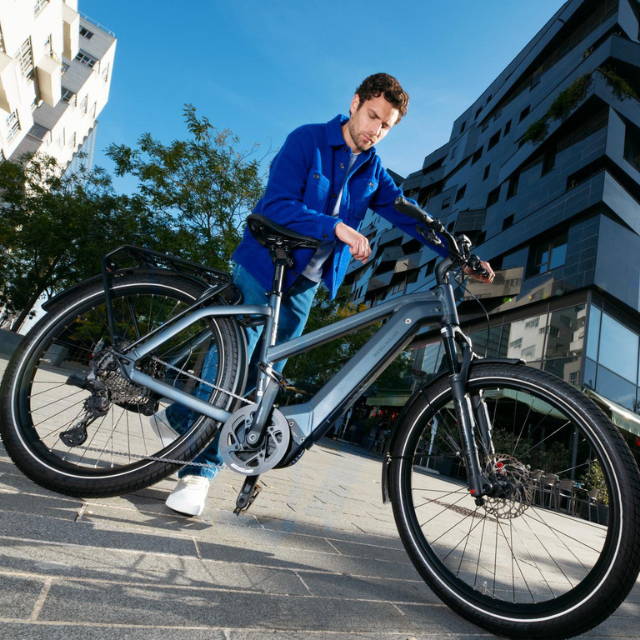E-Bike Motor Types: Hub vs. Mid-Drive Comparison
Written by: Rémy Rossi | March 31, 2025 | Time to read 5 min
Chocolate or vanilla? Hub or mid-drive? These are some important choices and I’m here to inform you on the e-Bike debate— the ice cream flavor feud can wait…

More about the Author: Remy Rossi
Rémy Rossi is a bike writer, mechanic, and educator who got his start in community-based bike shops and co-ops. With a decade in the industry, he still wrenches on bikes when he can and plays bike polo on a fixie.

Mid-drive motors

Pros
- Higher efficiency since the motor combines with the bike’s gears, resulting in more natural pedaling assistance and less strain on the motor
- Balanced weight distribution due to the low-down and central location of the mid-drive motor
- Mid-drive motors often produce higher torque to navigate steeper hills and climbs
Cons
- Mid-drive e-Bikes are typically pricier as the frame must be specifically designed to accommodate the motor
- Can put more stress on the chain and gears from the direct power transfer
Hub motors
Hub motors are built into the front or rear wheels of an electric bike, propelling the wheel forward. The added boost transfers directly to the wheel hub.

Pros
- Simpler design that’s easier to retrofit, access, and maintain
- Discreet and sleeker form factor that won’t add bulk around the bottom bracket area of the motorized bike
Cons
- Adds significant weight to either the front or rear of the bike which can influence handling
- The ride feel can seem like being pushed or pulled forward rather than more natural extension of pedal power
- Hub motors can be lower quality with cadence sensors instead of higher quality torque sensors for more responsive feel
Mid-drive vs. hub motor comparison
Ride feel

Mid-drive motors typically win out when it comes to providing a more natural boost and balanced ride experience. A mid-drive unit delivers power to the cranks which is where you put down your own power anyway. On the other hand, hub motors can give off the effect of being pushed or pulled along— though some riders appreciate this zippy, more energetic type of boost that can feel more like a small moped.
Performance and hill climbing
Weight distribution

Yet again, mid-drive motors have the edge here. As the name suggests, mid-drive motors are positioned centrally within the bike frame and low to the ground near the bottom bracket area. This location preserves the bike’s natural center of gravity despite adding a few pounds.
Hub-drive motors add weight to either the front or rear wheel. This extra heft can noticeably alter the handling compared to standard bikes. This is especially true with rear hub-drive e-Bikes with the batteries located within the rear rack, making for a very rear-heavy e-Bike.
Hub motors are also generally heavier than mid-drive motors, though there are exceptions. The MAHLE hub motors, for example, are used on certain premium road e-Bikes and gravel e-Bikes because of their compact and lightweight profile, ideal for fast and sleek road machines.
🤝 Why you can trust us for buying an e-Bike?
- Great prices: Get your next e-Bike for up to 60% off retail prices, in new or like-new conditions.
- Quality Guaranteed: Every e-Bike is rigorously certified by a team of professional mechanics, and comes with a 1-year warranty.
- Delivered to Your Door: Delivered to your home within a week. Change your mind? Return it thanks to our 14-day return policy.
Motor sensors
Mid-drive motors almost always have torque sensors while many simpler hub motors only have cadence sensors. Most Aventon e-Bikes have hub motors but they are equipped with torque sensors to improve acceleration and pedal assist performance.
Maintenance

Hub motors go easy on the drivetrain but require especially strong wheels since all the force is applied to the hub and spokes. The motor position within the wheel can also make it tricky to easily remove the wheel when fixing a flat tire or conducting other maintenance tasks.
Price

Key Takeaways
- Mid-Drive Motors for Performance: They offer a natural ride feel, better hill climbing, and balanced weight distribution, ideal for high-performance e-Bikes.
- Hub Motors for Simplicity: More affordable and easier to maintain, but can feel less natural and affect handling due to added wheel weight.
- Torque Sensors Matter: Mid-drive motors usually have torque sensors for smoother assist, while many hub motors rely on simpler cadence sensors.


